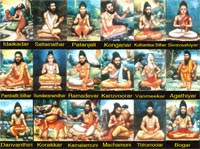1. Thirumoolar - Chidambaram
2. Bogar - Pazhani alias Aavinankudi
3. Karuvoor Siththar - Karuvoor, Thirukaalaaththi, Aanilaiyappa kovil
4. Pulipaani - Vaikaavoor near Pazhani
5. Konganar - Thirupathi, Thirumala
6. Machcha Muni - Thiruparangunram, Thiruvaanaikaal
7. Vallaba Siththar alias Sundharanandhar - Madurai
8. Sattai Muni SIththar - Thiruvarangam
9. Agathiyar - Thiruvananthapuram, Kumbeswar temple at Kumbakonam
10. Theraiyar - Thoranamalai (Malayala Naadu)
11. Korakkar - Perur
12. Paambaatti Siththar - Marudhamalai, Dwaraka, Virudhachalam
13. Siva Vaakkiyar - Kumbakonam
14. Roma Rishi - Thirukailai
15. Kaakapusandar - Trichu, Uraiyur
16. Idaikkaattu Siththar - Thiruvannamalai
17. Kuthambai Siththar - Mayiladuthurai
18. Patanjali Siththar - Chidambaram, Azhagar koil, Rameswaram
19. Pulasthiyar - Paapanaasam, Thiru aalavudaiyar koil
20. Thirumoolam Noakka Siththar - Melai Chidambaram
21. Azhaganna Siththar - Nagapattinam
22. Naradhar - Thiruvidaimaruthur, Karuvai nallur
23. Ramadevar - Azhagar malai
24. Markandeyar - Karuvai nallur
25. Pinnakkeesar - Nangunaaseri
26. Kaasibar - Rudhragiri
27. Varadhar - Thenmalai
28. Kanni Siththar - Perungaavoor
29. Danvanthiri - Vaitheeswaran koil
30. Nandhi Siththar - Kaasi, Thiruvaavaduthurai, Kaalangi
31. Kaduveli Siththar - Thirukaanjipuram
32. Viswamithirar - Kaasi, Thirivaavaduthurai, Kaalangi
33. Gowthamar - Thiruvarunai, Thiruvidaimaruthoor
34. Kamala Muni - Aaroor
35. Chandiranandhar - Thiruvaanjiyam
36. Sundharar - Vaaritcham, Thiruvaarur
37. Kaalangi Nathar - Thirukadavoor, Thiruppananthaal
38. Vaanmeeki - Ettikkudi, Thiruvaiyaaru
39. Agapey Siththar - Thiruvaiyaaru, Ettikkudi
40. Pattinaththar - Thiruvotriyur
41. Vallalaar - Vadalur
42. Sennimalai Siththar - Naangunaaseri, Kerala
43. Sadasiva Brahmenthirar - Neroor
44. Ramakrishnar, Sarada Deviyar - Belur madam
45. Ragavendra - Manthiralayam
46. Ramana Maharishi - Thiruvannamalai, Maathrupootheswar temple
47. Kumarakurabar - Kaasi
48. Nadana Gopala Nayagi Swamigal - Kaathakkinaru
49. Gnanandha Swamigal - All Thabovanas
50. Shridi Saibaba - Shridi
51. Sekizhar Perumaan - Madurai Meenatchi Amman
52. Ramanujar - Srirangam
53. Paramahamsa Yoganandha - California
54. Yuktheswar - Poori
55. Judge Swamigal - Pudhukottai
56. 21 Siththars sepulcher was in Aadi Parasakthi temple
57. Kannappa Naayanaar - Kalahasthi
58. Sivapragasa Adigal - Thirupazahaiyaarai Vadathali
59. Guru Baba Ramdev - 13 km from Boharan
60. Rani Sennammal - Pithanoor, Koppulimadam
61. Poojya Sri Siththa Narahari Guruji - Siththasiramam near Madurai Mariamman
62. Kuzhanthaiyaanandha Swamigal - Madurai Kaalavaasal
63. Muththu Vaduganathar - Singam Punari
64. Ramadevar - Nagapattinam
65. Arunagirinathar - Thiruvannamalai
66. Padakacheri Thavathiru Ramalinga Swamigal - Thanjai Punnainallur Maariyamman thirukovil
67. Mouna Saami Siththar - In the way towards Sengottai from Thenkaasi
68. Siruthondai Naayanar - Thiruchettangudi
69. Odakkathoor Swamigal - Lake side of Alsur, Bengaluru
70. Vallanaattu Mahasiththar - Vallanaadu
71. Subramaniya Siththar - Rettiyapatti
72. Sivagnana Bala Siththar - Mayiladuthurai Murugan sannidhi
73. Kambar - Nattarasan kottai
74. Nagalainga Swamigal - Ambalathaadaiyaar madam, Pondy
75. Azhagar Swamigal - Thennambakkam
76. Sivagnana Balaiya Swamigal - 6 kms North of Pondy
77. Siththanandha Swamigal - Karuvadikuppam, Pondy
78. Sakthivel Paramanandha Guru - Mudaliyarpet, Pondy
79. SriRama Paradhesi Swamigal - Right to the way towards Villiyanur
80. Akkaa Swamigal - Nerar Kuthiraikalam, Pondy
81. Mahaan Padae Swamigal - Sinnapaappu Samuthiram
82. Kambalai Gnanathesiga Swamigal - Ruththira bhooi near Pondy
83. Baghavantha Swamigal - In the shore of Gedilam river, Pudhupalayam
84. Kathirvel Swamigal - Srilanka, Siththan kudil near Pondy
85. Santha Nandha Swamigal - Near Sri Saradha Sivagangai peedam
86. Dhayanandha Swamigal - In the shore of Gedilam river, Pudhupalayam
87. Dhakshinamoorthy Swamigal - Palli Thennal next to Pondy
88. Gnaguru Kulla Swamigal - Pondy
89. Vedantha Swamigal - Thiru Muthukumar Swamigal Garden, Pondy
90. Lakshmana Swamigal - Pudhupatti, Pondy
91. Mannurutti Swamigal - Opposite to Sudhesi cotton mill, Pondy
92. Subramaniya Abinaya Sachidhanandha Bharathi Swamigal - Ellapillai, Pondy
93. Yogi Ram Surathkumar (Visiri Swamigal) - Thiruvannamalai
94. Kottur Swamigal - Kottur near Saathur
95. Thagappan Magan - Panaiyur near Girivalam vantha nallur
96. Narayana Saami Ayya - Nagarcoil
97. Bodhenthira Swamigal - Marudhanallur, Tanjore district
98. Avathoora Roga Nivartheeswarar Swamigal - Poonamallee, Chennai
99. Vaanmeega Nathar - Ettikkudi
100. Thambikalaiyan Siththar - United with the second linga of 108 lingas in Thiruvanmiyur
101. Meyvara Thambiraan Swamigal - Trichy, 25 kms from Jeyangonda Sozhapuram
102. Kugai Namachivayar Swamigal - Thiruvannamalai
103. Vaalai Guruswamy - Kommadikottai, Chidambaram
104. Pamban Swamigal - Thiruvanmiyur
105. Kumarasaamy Siththar Swamigal - Poorandan Palayam, Coimbatore
106. Periyazhvar Swamigal - Azhagar Kovil, Madurai
107. Maayamma - Kanyakumari
108. Paramacharyar - Kanchipuram
Note: It should also be noted that it's common practice for the Siththars to attain Samadhi at different places.





















